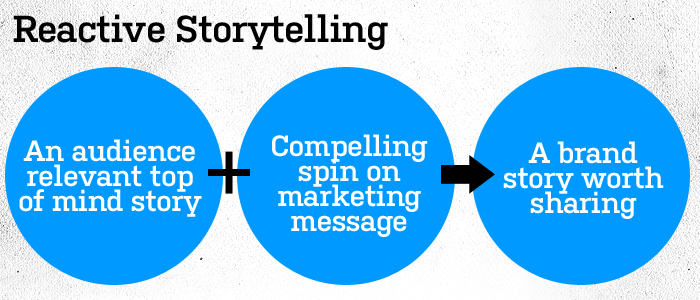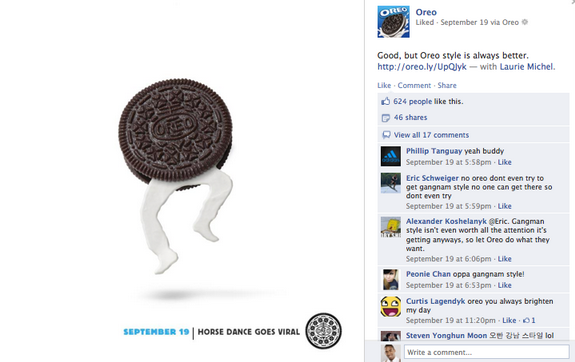After working with and helping hundreds of brands with Facebook, I’ve learned a thing or two about doing it effectively…
One of the most important things I’ve learned is that telling a brand story that is intentionally developed based on a top of mind event is an easy way to find success and connect with your audience. This idea needs to be worked into your marketing teams DNA so that you are ready to step out of the bubble and do things that aren’t planned and expected.
When you treat Facebook as a place where you are going to tell your brand story, you no longer stress over what you should talk about. You start to understand the power and value of a brands voice and how that can translate into things beyond the actual product and into things like pop culture or worldview insights. The process of leveraging a top of mind idea becomes easier and easier as you go through the process.
The key to finding success in deepening your relationship and maximizing your chances for going viral is often times related to your ability to react to opportunities. Some of these opportunities exist and can be specifically attributed to your brand while others can be more attributed to the interests of your target audience. At the end of the day you want to share content that isn’t boring and that is worth sharing on social media. This concept is what I call, Reactive Storytelling.
Understanding Reactive Storytelling
The intentional integration of a top of mind story or idea with a compelling marketing message that your audiences finds relevant and compelling.
When a business uses Reactive Storytelling they are able to leverage a human truth or an insight to generate instant feedback. Whether it’s the utilization of a Facebook post or the development of a YouTube video to tell and share a compelling story, reactive story is a great way to spark conversation and deepen your brand connect with your fans.
There are three distinct actions that happen organically that can be identified used to deliver a Reactive Storytelling piece of content. This includes (1) a cultural action (2) a brand relevant action or (3) a niche action. Each of these actions are organic stories, content from users or information that can be leveraged for your content marketing strategy to deliver something that is compelling and worth sharing.
Here’s how you can find these actions and a few examples of how you can turn them into great stories:
Brand Relevant Reaction
Consumers interact with and have conversations about brands on a regular basis. The interactions range from a simple shout out to a gut-wrenching customer service complaint. These comments, posts or tweets are specifically related to the brand and could have a positive or negative sentiment. This form of interactions can happen on any social media channel and presents the brand with an opportunity to react in a unique, compelling way.
Brands have typically responded to consumer complaints with apologies, coupons to mute the noise or a call to action to take their complaint behind closed doors. Recently however, brands are finding ways that are fun, engaging and compelling to interact with customers. Whether it’s a complaint or a compliment, brands are becoming more and more reactive in recognizing the value of telling a brand story through their response. The following was a video response developed after a guy put up a sarcastic post on the bodyform Facebook page expressing how disappointed he was in the realities of “That time of the month”.
It’s important to note that brand specific reactive storytelling isn’t limited to content created by consumers. Other organizations, businesses and influencers often say things that can also be linked to your brand story. The ability to leverage a conversation that one brand or influencer is having that is linked to your industry presents an opportunity to get your story in front of an additional audience. Upon using reactive storytelling in this manner, you have an opportunity to get your story in front of an audience that you typically would not have the ability to speak to.
The following is a reaction from AMC Theatres that resulted in a wide range of earned media and a significant spike in relevant brand conversations across multiple channels. Oreo started the conversation with a simple tweet asking if any of their followers have snuck Cookies into the Movie Theatre before. The AMC Theatres community manager caught wave of this tweet and quickly responded with a witty, clever and simple response. The internet erupted. The twitter exchange that kick started one of their highest spikes in brand relevant conversations can be seen below:
A brand relevant reaction that tells your story in a relevant way doesn’t need to be marketing focus. Your reaction can also stem and be developed with the sole intent of fixing a wrong for a customer. An example of how this can be done effectively can be found in this video from Ramon De Leon when he “delivered the wow” after his staff didn’t meet customer or company expectations. Check out this response!
Cultural Specific Reaction
A Cultural Reaction is one that is built on a story that is being covered in the news around the world. When a brand responds to something that has already got the world talking it’s an easy way to leverage an already popular concept and make their brand go viral. The reason why these have such large reach is that it’s essentially a parody of something that is known by all and can connect with everyones interest. When Red Bull Stratos took over the media and social media channels with the Sky Dive from Space – Other brands jumped on the bandwagon immediately to tell their story in an impactful, compelling way. Whether it was Kit Kat or LEGO – Both brands leveraged a top of mind story to keep people talking about their brand.
Here’s a great example of reactive storytelling from the folks at Las Vegas Tourism reacting to Prince Harry and his over the top (epic) weekend in Sin City. Unlike Skittles, they took their story further than just a Facebook post and implemented an entire campaign around the incident. We all know the saying, “What Happens in Vegas Stays in Vegas”, it’s the mantra of the city. So when pictures of Prince Harry having a couple drinks and walking around naked surfaced the web, Las Vegas took offense to the notion that “the code” was officially broken. Here is how they told the story:
Facebook has confirmed that images are shared, commented on and liked 2x more often than a simple text status update. Thus, using compelling visuals that tell your story can be a great way to generate additional buzz for your concept online. Las Vegas launched this campaign with a compelling twist on the iconic “Keep Calm and Carry on” poster by adding the word Harry at the end along with the #KnowTheCode hashtag and URL.
Niche Specific Reaction
A Niche Specific Reaction is when a brand tells a story through somewhat of an “inside joke” within a certain group. At the end of the day, each of us can be placed into one or multiple groups that society would typically label us based on a few common traits and interests. Whether it’s a Football Fan, a Yogi or an internet geek – there are a variety of different niche groups we can be labelled as and placed into.
The ability to tie a marketing concept to a niche topic or story that a specific group will find interesting is a key opportunity for a brand looking to deepen it’s level of engagement with consumers. When a brand utilizes this form of reactive storytelling they can very easily limit the amount of reach that this story will connect with. The right story however will cross over from one niche group into the interest of others. An example of a Niche reaction can be found in The Avengers reactive ad developed as a spin off of the VW Superbowl Force commercial.
The Avengers marketing team quickly recognized the popularity of the VW “Force” Star Wars ad and were probably fans of the Ad themselves. The fact that the VW ad built on a story that is targeted towards a very similar market that the Avengers would be targetting – It’s the perfect fit for reactive storytelling. Whether the audience is defined as super hero lovers, star wars geeks or simply nerds – This audience would find both concepts compelling and interesting.
The image below was developed by Oreo and is a niche reaction to the internet sensation, Gangnam Style. At the time of this post, Gangnam Style wasn’t as popular as it is today and was arguably still on the rise in terms of popularity.
Opportunities like these pop up and can only be capitalized on if your brand is actually listening. You must be listening to conversations about your brand and conversations that are happening within the communities of interest to your audience. Listening will allow you to find out what topics are trending, what insights can be gathered and what conversations deserve a reaction from your brand.
Conclusion
Reactive Storytelling is only possible through listening and the commitment to being agile with your content marketing approach. If you’re looking to implement reactive storytelling into your strategy it’s extremely important to understand the interests and worldview of your target audience. It’s also important that you don’t make the same anti-viral mistakes many others do when working with social media. Now that you know what Reactive Storytelling is all about, you need to know where to look for these opportunities. Over the last couple of years I’ve tested a lot of different channels for trends, insights and upcoming opportunities here are a few great places to check for the next big thing:
BuzzFeed – When it comes to identifying and creating awesome content, BuzzFeed is one of the best online. Whether it’s finding throwbacks to your childhood or simply providing head scratching info – You can find it here.
Reddit – Some call it the homepage of the internet and for good reason. If there is anything that is about to go viral or anything that is belly laugh worthy it can be found somewhere on Reddit.
Twitter – Want to know exactly what your customers are saying about your brand? Want to have easy access to the most timely and topical conversation and trends happening around the world? Look no further.
So what do you think about reactive storytelling? Have you seen any of these kinds of post in the wild?



